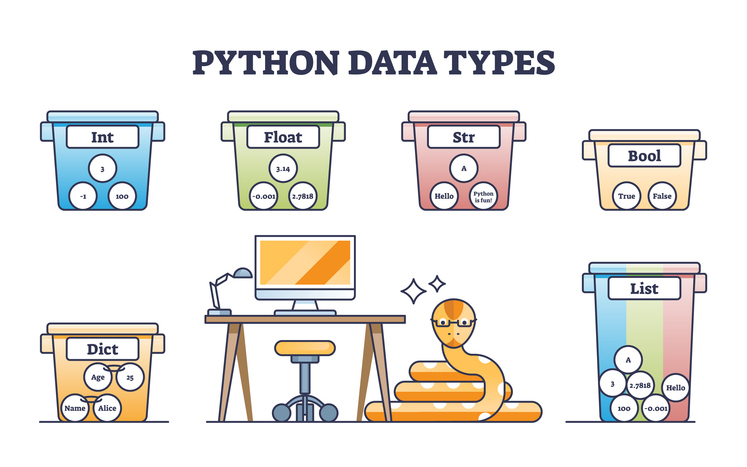5 min read
Mastering Python Iterable Data Types: Lists, Sets, Tuples, and Dictionaries
Picture yourself embarking on a grand adventure, not through treacherous landscapes or ancient ruins, but through the realms of Python programming,...
4 min read
![]() The Amazing Team at Skills Data Analytics
:
Mar 12, 2024 7:29:28 AM
The Amazing Team at Skills Data Analytics
:
Mar 12, 2024 7:29:28 AM
Uncover the world of data analysts as we delve into the various job types, training requirements, and salary expectations in this exciting field.
Data analysts play a crucial role in today's data-driven world. They are responsible for collecting, analyzing, and interpreting large sets of data to help organizations make informed decisions. By exploring the role of a data analyst, we can better understand the skills and responsibilities involved in this profession.
A data analyst's main tasks include collecting data from various sources, cleaning and organizing it, and performing statistical analysis to identify trends, patterns, and insights. They also develop reports and visualizations to present their findings to stakeholders, helping them make data-driven decisions.
Data analysts need to have a strong background in mathematics, statistics, and computer science. They should also be proficient in programming languages such as Python or R and have a good understanding of data analysis tools and techniques.
In addition to technical skills, data analysts should possess strong problem-solving and critical-thinking abilities. They must be able to analyze complex data sets and draw meaningful conclusions to guide decision-making.
Overall, exploring the role of a data analyst reveals the importance of this profession in today's data-driven world and highlights the skills and responsibilities required to excel in this field.
Becoming a data analyst typically requires a combination of formal education and practical training. Several training and education paths aspiring data analysts can pursue to develop the necessary skills and knowledge.
One common path is to earn a bachelor's degree in a field such as mathematics, statistics, computer science, or economics. These programs provide a strong foundation in data analysis principles and techniques and often include courses in programming, statistics, and data visualization.
Alternatively, individuals can choose to pursue a master's degree in data analytics or a related field. These programs offer more specialized coursework and often include hands-on projects or internships to provide practical experience.
In addition to formal education, aspiring data analysts can also enhance their skills through online courses, bootcamps, or self-study. Numerous online platforms offer courses in data analysis, programming, and statistics, allowing individuals to learn at their own pace.
Overall, the training and education paths for aspiring data analysts provide a range of options to acquire the necessary skills and knowledge. Whether through formal education or self-study, individuals can pursue a path that aligns with their interests and career goals.
Data analysis encompasses a wide range of job types, each with its unique focus and responsibilities. Understanding the different job types in data analysis can help individuals identify the career path that best suits their interests and skills.
Some common job titles in data analysis include data analyst, business analyst, data engineer, data scientist, and data architect. While these titles may vary across industries and organizations, they all involve working with data to derive insights and drive decision-making.
Data analysts primarily focus on collecting, cleaning, and analyzing data to identify trends and patterns. They often work closely with stakeholders to understand their data needs and provide actionable insights.
Business analysts, on the other hand, bridge the gap between data analysis and business strategy. They use data to identify opportunities for improvement, optimize processes, and drive business growth.
Data engineers are responsible for designing and building the infrastructure needed to store and process large volumes of data. They work closely with data analysts and data scientists to ensure data availability and reliability.
Data scientists, on the other hand, use advanced statistical and machine learning techniques to uncover insights and build predictive models. They often work on complex problems and leverage large datasets to develop data-driven solutions.
Data architects focus on designing and maintaining the overall data structure and architecture of an organization. They ensure data integrity, security, and accessibility, laying the foundation for effective data analysis.
Overall, the different job types in data analysis offer a range of opportunities for individuals interested in working with data. Whether as a data analyst, business analyst, data engineer, data scientist, or data architect, there are various paths to explore in this field.
Data analysts are in high demand, and their salaries reflect the value they bring to organizations. The salary expectations for data analysts can vary based on factors such as experience, location, industry, and company size.
According to recent surveys and job market data, the average salary for data analysts ranges from $60,000 to $90,000 per year. Entry-level data analysts can expect to earn around $60,000, while those with several years of experience and advanced skills may earn upwards of $90,000.
Location also plays a significant role in determining salary expectations. Data analysts working in major tech hubs such as San Francisco or New York City tend to earn higher salaries due to the higher cost of living and increased demand for data-related skills.
Industry and company size can also impact salary expectations. Data analysts working in industries such as finance, healthcare, or technology often earn higher salaries compared to those in other sectors. Similarly, larger companies with more complex data analysis needs may offer higher salaries.
It's important to note that salary expectations can vary widely based on individual circumstances and market conditions. It's always a good idea to research industry trends, salary ranges in your specific location, and the requirements of the job to negotiate a fair and competitive salary.
Overall, data analysts can expect competitive salaries and ample opportunities for career growth and advancement in this dynamic and evolving field.
The field of data analysis is constantly evolving, driven by advancements in technology and the increasing importance of data-driven decision-making. As we look to the future, there are several trends and opportunities that data analysts can expect to encounter.
One major trend is the growing use of artificial intelligence and machine learning in data analysis. These technologies enable data analysts to automate repetitive tasks, uncover hidden insights, and make more accurate predictions. Data analysts with skills in machine learning and AI are likely to be in high demand.
Another trend is the increasing focus on data privacy and security. With the rise in data breaches and privacy concerns, organizations are placing greater emphasis on protecting sensitive information. Data analysts who can ensure data privacy and compliance will be highly valued.
The rise of big data and the Internet of Things (IoT) also present opportunities for data analysts. As more devices and systems generate massive amounts of data, data analysts will play a crucial role in extracting actionable insights from this data and helping organizations leverage it for strategic decision-making.
Data visualization is another area that is expected to grow in importance. As data becomes more complex and abundant, data analysts who can effectively visualize and communicate insights will be in high demand. Visualizations help stakeholders understand complex data and make informed decisions.
Lastly, data analysts can expect to see increased collaboration with other departments and roles within organizations. As data-driven decision-making becomes more integral to business operations, data analysts will work closely with teams such as marketing, finance, and operations to provide insights and support strategic initiatives.
In conclusion, the future of data analysis holds exciting opportunities driven by advancements in technology, increasing data privacy concerns, the rise of big data and IoT, the importance of data visualization, and the growing collaboration between data analysts and other departments. Data analysts who adapt to these trends and continue to enhance their skills will be well-positioned for success in this rapidly evolving field.
If you’re interested in more job tips and ways to advance your career, check out more details at Skills Data Analytics.

5 min read
Picture yourself embarking on a grand adventure, not through treacherous landscapes or ancient ruins, but through the realms of Python programming,...

4 min read
Data Analytics in the Retail Industry: A Game-Changing Strategy for Success in the USAIntroductionData analytics has emerged as a powerful tool that...

2 min read
Data visualization plays a crucial role in data analytics by transforming complex data sets into visual representations that are easy to understand...